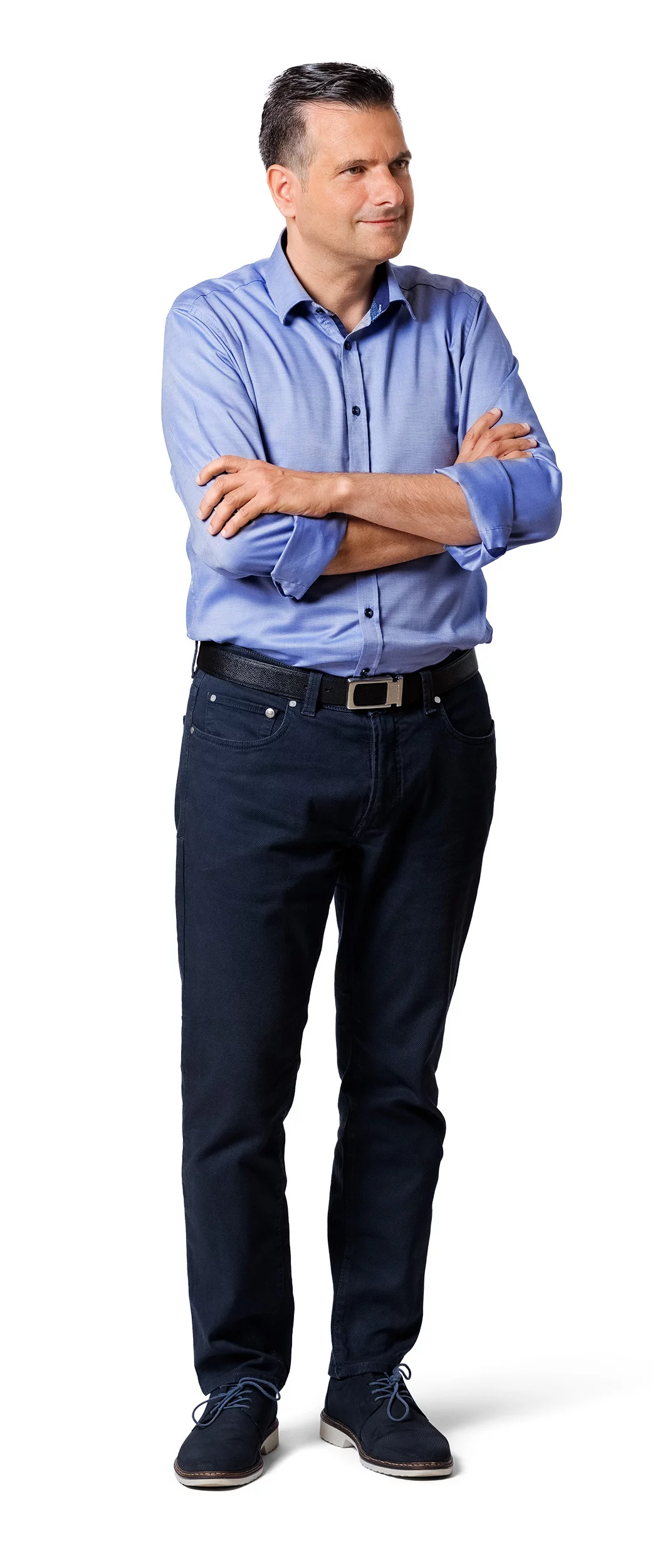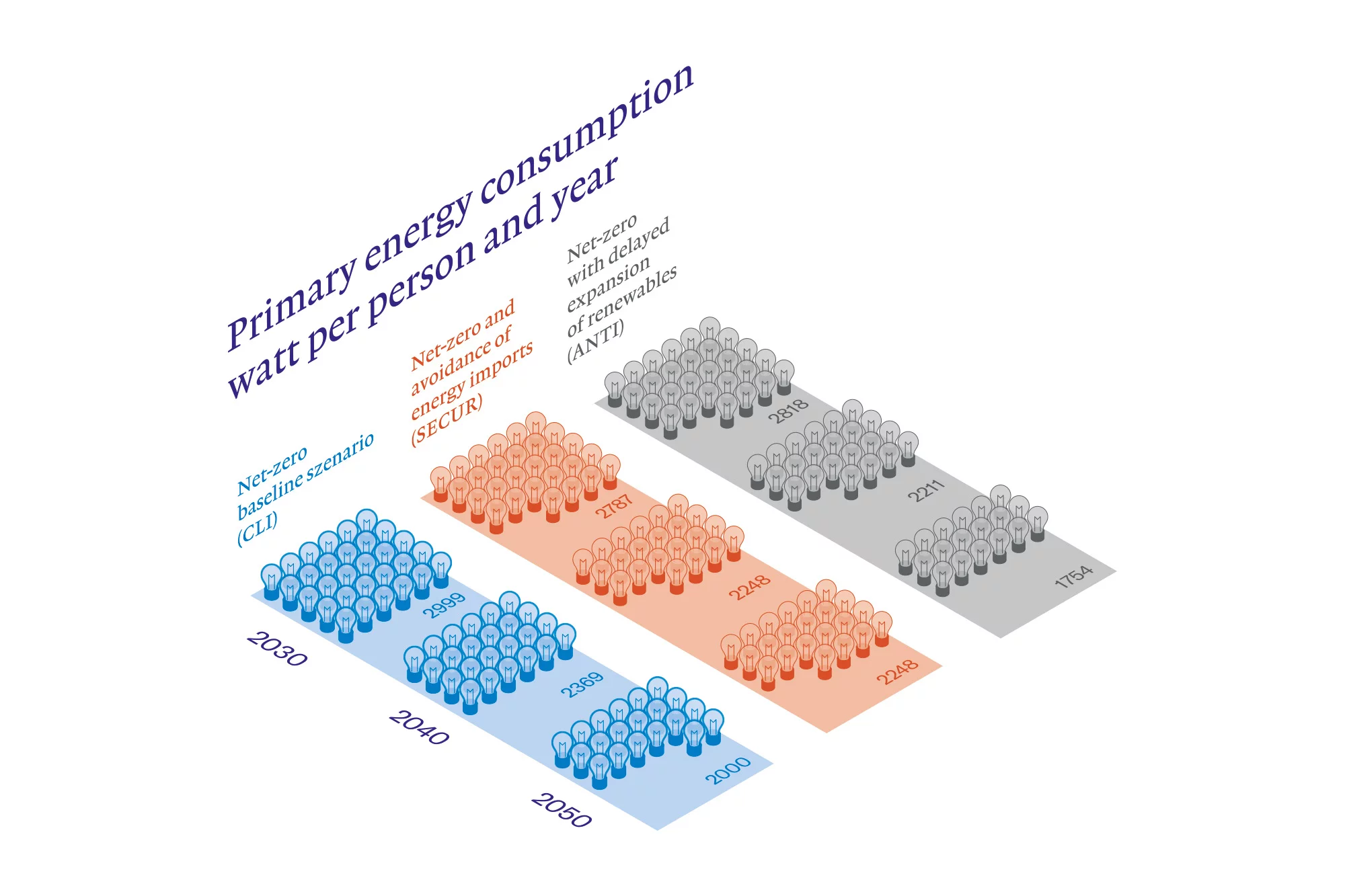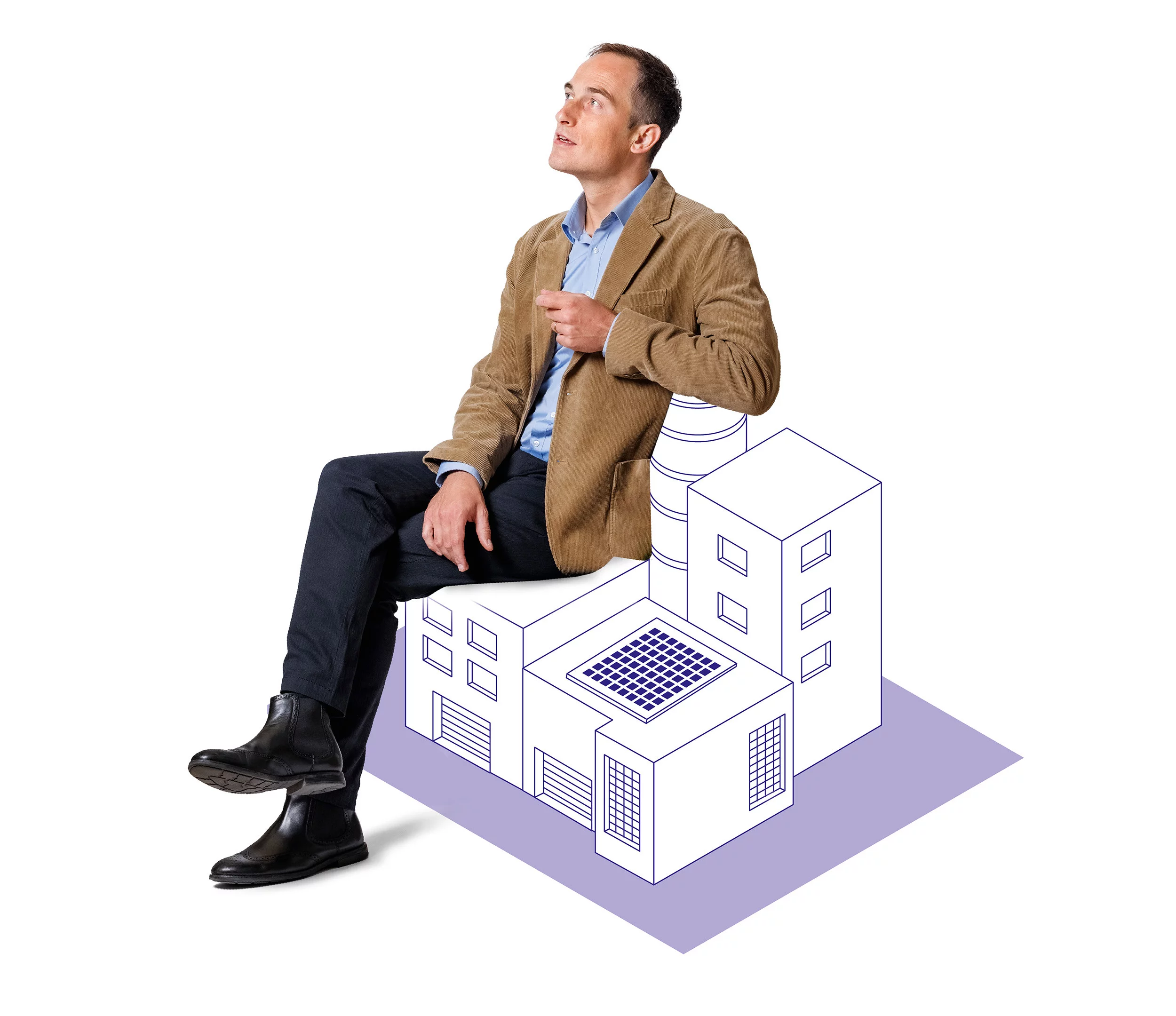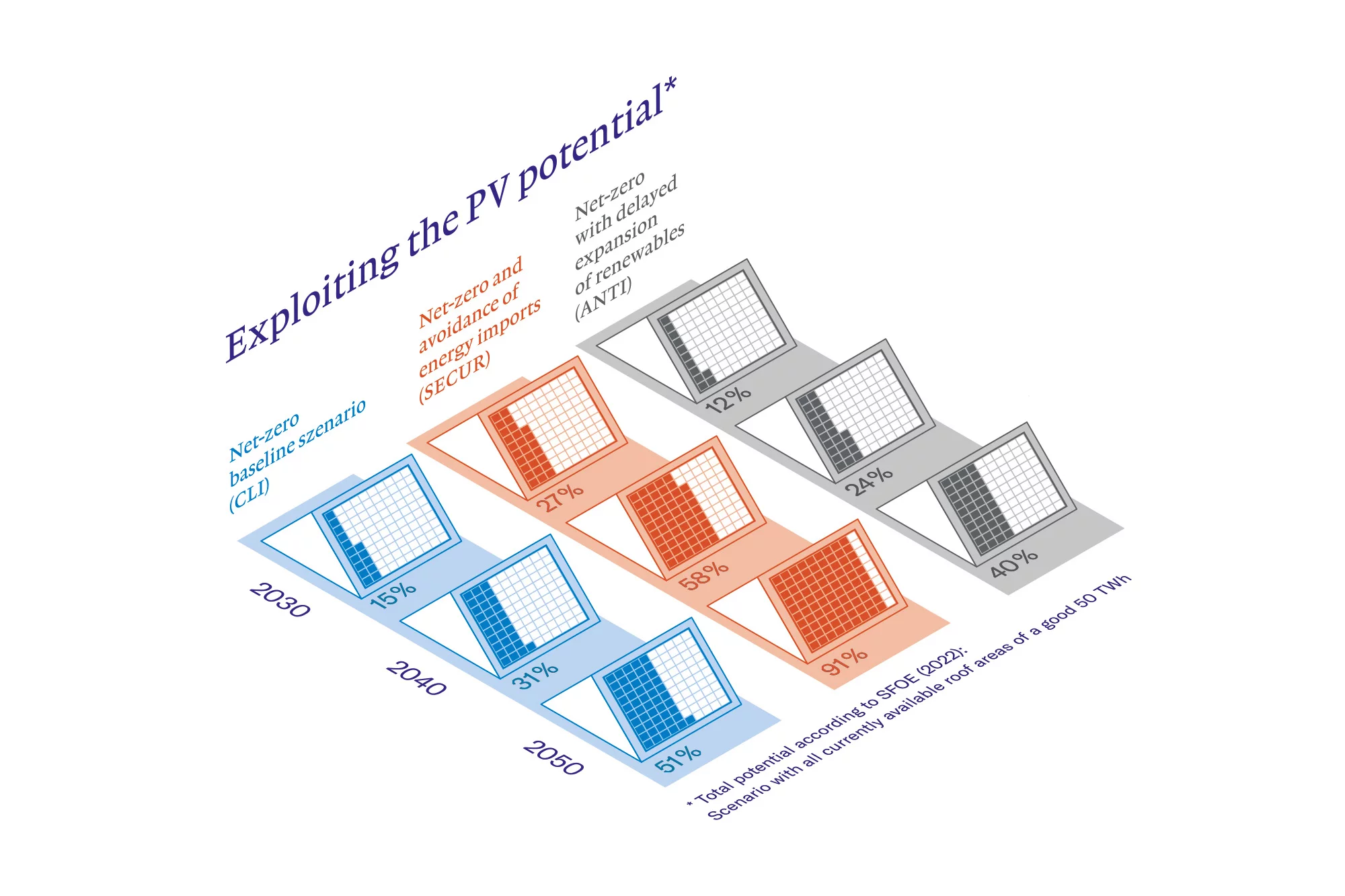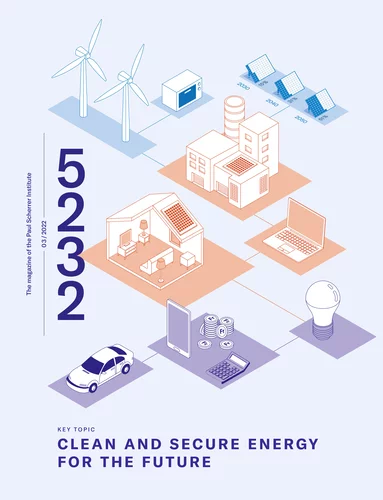The goal is clear: zero greenhouse gas emissions by 2050. But how can Switzerland manage the energy transition at the lowest costs possible and ensure the security of the energy supply? PSI researchers are providing answers with a computer model that is unique in its scope.
When Tom Kober talks about his work, he makes one thing clear right away: “We don’t predict the future.” This could be confusing at first, since “foresight” is Kober’s special field. Even though Kober looks into the future, he does not make predictions. “We calculate scenarios on the what-if principle,” Kober says, “but every computational model is still just an abstraction of reality, which means that certain aspects may well be disregarded.” None of these scenarios will unfold in that exact way. Nevertheless, they should provide valuable support to decision-makers in politics and business. “The scenarios show possible options for action and the consequences they have, which is particularly interesting for the comparison of different scenarios.”
For more than 15 years, Kober has been dealing with energy systems, CO2 emissions and the pressing questions posed by advancing climate change. Since 2016 the 45-year-old has been the head of the Energy Economics Group, an important team in the Laboratory for Energy Systems Analysis (LEA) at PSI. “PSI is the ideal place for this interdisciplinary research,” confirms Russell McKenna, the head of the LEA. The LEA represents the ideal complement to the main areas of work in PSI’s two research divisions Nuclear Energy and Safety, and Energy and Environment. “We produce market analyses to support, among others, our colleagues who are developing electrolysers or fuel cells. We in turn benefit from the data and expertise of the colleagues who are developing new technologies,” McKenna says.
This competence is also known to Innosuisse, the Swiss Innovation Agency. It determined that despite plenty of valuable foresight research on energy systems in Switzerland, this had not been well coordinated. In 2017, the agency launched a project – Joint Activity Scenarios and Modelling (JASM) – charged with calculating a development path for Switzerland towards a climate-neutral society. The aim was to provide orientation for politics and business. Participants included the eight Swiss Competence Centres for Energy Research (SCCERs). Besides PSI, this included other institutions in the ETH Domain such as Empa, EPFL, WSL, and ETH Zurich, the Lucerne University of Applied Sciences and Arts, and the universities in Basel and Geneva. Each of these research institutions has particular strengths and concentrates on specific research questions.
The modelling team in the PSI Laboratory for Energy Systems Analysis is recognised nationally and internationally for the STEM (Swiss Times Energy Systems Model) it developed. Kannan Ramachandran and Evangelos Panos were largely responsible for its development. “It is the only model that can map development paths for the entire Swiss energy system over long periods of time with very good temporal resolution and an extremely high level of technical detail,” says Evangelos Panos, a researcher in the Energy Economics Group. Other researchers who use energy models only consider one specific year in the future, not a period covering several decades. In the JASM joint project supported by Innosuisse, PSI researchers investigated three net-zero scenarios in comparison with a baseline scenario in which, by 2050, CO2 emissions would only be reduced 40 percent below 1990 levels: a net-zero CO2 emission reduction scenario (CLI), a variant that also calculates a reduction in energy imports to a minimum (SECUR), and a variant with fragmented expansion potential for new renewable energy sources (ANTI).
Last year Tom Kober’s team presented the results of their models. Bad news first: to reach the net-zero goal by 2050, substantial efforts will be necessary. To achieve this goal in the most cost-effective way possible, the installed photovoltaic capacity needs to double every ten years, and three-quarters of all residential buildings will then have to be warmed by heat pumps. This would halve Switzerland‘s average per capita energy consumption compared to today. Thus Switzerland would transform itself into the much-cited 2,000-watt society, meaning that the annual primary energy consumption per capita would correspond to an average output of 2,000 watts. Today it is nearly 4,000 watts per person. With a delayed expansion of renewable energy sources, the average power requirement would have to be brought down even further, to 1,750 watts. In this case, the net-zero target could be achieved primarily through extra efforts to conserve energy – which would bring correspondingly higher costs, for example for more thermal insulation and better process integration.
Photovoltaics has a major role to play in the energy transition. Switzerland could harvest around 50 terawatt-hours of solar power annually if all available surfaces were used. Today, however, only four percent of them are in use. If the country wants to largely do without energy imports by 2050, more than 90 percent of these surfaces would have to be exploited. On the other hand, only around 50 percent of the possible solar energy surfaces would need to be used to achieve the goal in the baseline scenario. In the scenario with delayed expansion, it would be 40 percent.
In the meantime, other research institutions have also presented their JASM results and summarised them in a synthesis report. Besides that, there are also the federal government’s scenarios – known as Energy Perspectives 2050+. The researchers agree on the main findings, but there are differences as well. The PSI models, for example, indicate higher costs than in other groups‘ results.
PSI is the ideal place for this interdisciplinary research.
“Some events, however, cannot be predicted by even the best computational models, for example when a virus holds the world in suspense or a war threatens the reliable supply of fossil fuels,” laboratory head McKenna points out. Such shock events are topics explored by SURE (Sustainable and Resilient Energy for Switzerland), a research project in the SWEET programme (Swiss Energy Research for the Energy Transition) of the Swiss Federal Office of Energy. In SWEET, ten research partners, led by Tom Kober, are investigating how the energy system behaves in the event of a shock and what countermeasures can be taken. With regard to the Covid-19 pandemic, experts are quite sure that the immediate effects on the energy system will only be short and medium term, and that long-term goals such as decarbonisation will not change.
The war in Ukraine could be a different story. As a result, some scenarios in PSI’s JASM report have suddenly been brought into sharp focus. Today around three-quarters of Switzerland’s total annual energy consumption is imported. Besides decarbonisation, the SECUR scenario is designed to achieve independence from imports as rapidly as possible, for example by using domestic renewable energy to produce hydrogen. In such a scenario, it is not only necessary to increase electricity production, but also to conserve more energy and enhance the flexibility of the energy system to integrate large amounts of energy from renewable sources. This also makes climate protection efforts around two and a half times more expensive.
As an industrial engineer, Kober is particularly interested in such economic aspects of the transformation of energy systems, as well as in the technical interdependencies. The question is: What does it cost if we make this or that decision in a scenario, and what interactions result from this in a system as complex as the energy system? The answer is unambiguous: it’s not going to be cheap. Society will have to bear substantial costs, depending on the scenario. No wonder: if Switzerland wants to get from its CO2 output of 43.4 million tonnes per year (as of 2020) to net-zero by 2050, then in the future CO2 emissions will have to decrease every year by one and a half million tonnes on average compared to the previous year. But there’s also good news: this decarbonisation of the energy supply is technically possible and in principle affordable – if the measures are chosen wisely.
For the energy transition we also need new financing instruments and government guarantees.
Looking at the costs of the baseline scenario in which CO2 emissions fall by 40 percent by 2050 compared to 1990, one can see that the total costs of the energy system by 2050, compared to today, will more than double. There are additional costs associated with achieving the net-zero target. Depending on the scenario, these will be between around 180 and 840 Swiss francs per capita annually up to 2030. Up to 2050, the additional costs will be between 1,440 and 3,750 Swiss francs. Evangelos Panos explains the differences in costs between the scenarios: “The reasons for such a broad range are different developments in energy source prices, energy technologies, resource availability, market integration, acceptance of technologies and dependence on energy imports. If the framework conditions change, this results in a different technology mix, combined with rising costs for the energy system if the inexpensive climate protection options are only available to a limited extent.”
So it’s clear: the energy transition will be expensive – how expensive depends on political decisions. The hope of saving money by doing nothing is something Kober rejects outright: the ANTI scenario, in which more cost-effective measures for the energy transition such as the expansion of renewables make only slow progress, is the most expensive scenario of all. Instead of just 1,440 francs as in the net-zero baseline scenario (CLI), the Swiss would then have to pay an additional 3,750 francs per year in 2050. If expansion of renewable energy sources is delayed, hydrogen would become significantly less important, since the domestic resources for production would not be fully available. To compensate for this, measures to conserve energy would have to be given preference, and energy from environmentally friendly sources would have to be imported from abroad at high prices. Even if Switzerland wants to be as independent as possible from energy imports, the additional costs of the energy transition would almost double in 2050 to 2,560 Swiss francs per year, mainly due to the accelerated installation of photovoltaics and better building insulation in combination with heat pumps.
One key to the success of all ambitious development paths, aside from the costs, is acceptance. In the ANTI scenario, the researchers assume the population takes a pessimistic and defensive stance, which would set the energy transition back by ten years. The referendum in June 2021, in which Swiss voters rejected important climate protection measures in the amended CO2 Act, shows that this is not far-fetched.
Kober also sees the world of finance as having an obligation. The energy system of the future is increasingly capital-intensive. Although people will save on fuel, larger sums must first be invested, for example in photovoltaic installations or hydrogen technology. Banks assess the risks of investments and distinguish between mature technologies like photovoltaics or thermal insulation, and other technologies that today are only on the way to market maturity. But the energy transition will only succeed if new technologies associated with hydrogen, or with separating CO2 out of exhaust gases from power plants or incineration facilities, are introduced on a massive scale. Here new financing instruments and government guarantees are needed.
Which scenario is now the best or the most likely? As has been said: no scenario of the PSI JASM report predicts the future; none has only advantages, inasmuch as there is no good or bad. But there are a few basic principles common to all scenarios:
- A price must be put on greenhouse gas emissions – that means energy prices must reflect the costs for the environment and for people. In addition, the decarbonisation measures must be coordinated and implemented rapidly, otherwise it will get really expensive.
- Electricity from low-emission sources, especially renewables, is the raw material of the energy transition. Switzerland’s power consumption could increase from around 60 terawatt-hours today to 80 in 2050. To meet this need and to compensate for the gradual phase-out of nuclear energy, the output from photovoltaics must at least double every decade.
- More weather-dependent electricity production, such as from photovoltaic and wind power plants, means that the energy system has to react much more flexibly. This requires additional energy buffers (short-term and seasonal) in the form of battery, thermal or chemical storage, as well as the willingness of consumers to adapt their energy consumption to the energy supply.
- Without the separation and underground storage of CO2, the decarbonisation goals cannot be achieved. Switzerland must coordinate this with its neighbours.
- Openness to technology pays off. Competition combined with incentives can bring the best results at the lowest costs.
Research using the STEM model continues and will be extended to other aspects of the sustainability and resilience of the energy system, most notably the social impact of the energy transition. Tom Kober is optimistic that the energy transition can succeed: “What we need now are decisive measures and concrete regulations that everyone can follow to control carbon emissions.”
6 million equations – one energy system
The trained software engineer and energy modeller Evangelos Panos has built up a complex computational model over the years with his colleague Kannan Ramachandran and a team of other researchers: STEM, the Swiss TIMES Energy System Model. It consists of six million equations with six million variables that describe various aspects of the Swiss energy system. The variables are linked in many dimensions via the equations. If you change one variable, such as the price of emitting a tonne of CO2 or the expansion of photovoltaics, dozens of other variables change, sometimes in unforeseen ways.
It is inconceivable to work out such a gigantic system of equations with paper, pencil and pocket calculator. Even the special computer that Panos uses takes several hours to solve the system of equations for a single scenario. But the modelling of energy systems using different scenarios is more than that, because it involves converting specialist knowledge about the energy system from different disciplines into efficient algorithms in order to be able to calculate them using computers at all. Thus it’s no wonder that it took months of meticulous, detailed work to calculate all of the scenarios and their variants in the JASM project.
In comparison to models from other research teams, PSI’s STEM has some outstanding distinctive features – but naturally, it can’t do everything. It is a model focused on technological and economic optimisation. For example, it does not make any statements as to how the scenarios in Switzerland will affect the labour market or value creation. The researchers also excluded emissions from international air traffic and emissions that occur abroad in connection with the importing of goods into Switzerland. Therefore, the modelling of the Swiss energy system is not a solo task of PSI, but a contribution embedded in cooperative research involving other renowned research groups: working together to ultimately draw a comprehensive picture, with as many facets as possible, of the transformation of the energy system.

